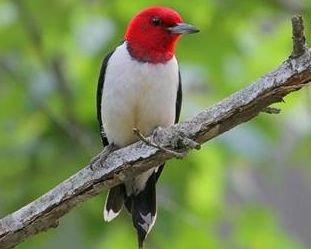
Publisher:
Bonnie King
CONTACT:
Newsroom@Salem-news.com
Advertising:
Adsales@Salem-news.com

~Truth~
~Justice~
~Peace~
TJP
Jan-12-2011 15:31

 TweetFollow @OregonNews
TweetFollow @OregonNews
Massive Six-State Habitat Restoration Project Sees Progress on 130,000 Acres in Year One
Salem-News.comThe goal is returning vegetation in key locations to a condition approximating its natural state.
 Red headed Woodpecker photo by Greg Lavaty |
(WASHINGTON D.C.) - Leaders of a massive, six-state, 1.1 million-acre habitat restoration initiative that will potentially benefit a host of rare birds and many species of wildlife say that the project has had an auspicious start with restoration work initiated on about 130,000 acres.
The goal of the project, which focuses on the restoration of native ecosystems such as barrens, glades, and open oak and open pine woodlands, is taking place in Tennessee, Alabama, Missouri, Arkansas, Kentucky and Illinois.
The goal is to return the vegetation in dozens of key locations to a condition approximating its natural state in the hopes that many wildlife species that were once abundant, can again thrive. The initiative is being lead by about a dozen state and federal land-managing agencies and non-governmental organizations associated with the Central Hardwoods Joint Venture (CHJV), a public-private partnership for conservation in the Central Hardwoods Bird Conservation Region (see www.chjv.org).
“One of the biggest challenges we face is overcoming decades of aggressive fire prevention efforts that, though well intentioned, have resulted in the loss of vital understory shrub and grass/forb communities that were part of the historic landscape,” said Jane Fitzgerald, Project Director for American Bird Conservancy (ABC), one of the leaders in this effort.
“Most of the targeted ecosystems are unfortunately now overgrown by dense stands of trees that diminish the suitability of the environment for native species. Without near-term restoration efforts, such as those now taking place, the seed banks and rootstock that would allow the understory to recover may no longer be viable,” Fitzgerald said.
Restoration work in 2010 included such activities as vegetation thinning and prescribed burns. Those kinds of efforts have already been taking place on more limited acres, but with the help of sophisticated spatial models developed by CHJV staff, can now increase in scale.
For example, the scientists are now able to better identify sites most conducive to restoration work and to see where inter-agency partnerships can help to enact habitat work across landscapes at scales capable of sustaining relatively large and healthy populations of target species.
While there is reason to expect that the habitat work will continue at a pace similar to that of 2010, local partnerships hope that the synergy they create by working together will help to garner increased resources and capacity in coming years.
Many of the bird species that would benefit from this long-term restoration effort are listed on the U.S. WatchList of birds of conservation concern due to dwindling populations or habitat loss.
These include the Red-headed Woodpecker, Brown-headed Nuthatch, Bachman’s Sparrow, Prairie Warbler, and Blue-winged Warbler—species that need open habitats rather than closed-canopy forests , and that have either disappeared from the target areas or have been greatly diminished from historic levels. In addition to birds, other wildlife that may benefit from the project include: Indiana bat, red bat, eastern gray treefrog, Texas mouse, eastern woodrat, eastern chipmunk, giant swallowtail butterfly, Diana frittalary butterfly, lichen grasshopper, Dusky gopher frog, Northern Cave Crayfish and collared lizard. Threatened and endangered plants that may benefit include Tennessee Coneflower, Tennessee Milk Vetch and Eggert’s Sunflower.
Fitzgerald added that there is also great potential for local economies to benefit directly from the project by receiving contracts to carry out the restoration work.
Source: American Bird Conservancy
Articles for January 11, 2011 | Articles for January 12, 2011 | Articles for January 13, 2011




Quick Links
DINING
Willamette UniversityGoudy Commons Cafe
Dine on the Queen
Willamette Queen Sternwheeler
MUST SEE SALEM
Oregon Capitol ToursCapitol History Gateway
Willamette River Ride
Willamette Queen Sternwheeler
Historic Home Tours:
Deepwood Museum
The Bush House
Gaiety Hollow Garden
AUCTIONS - APPRAISALS
Auction Masters & AppraisalsCONSTRUCTION SERVICES
Roofing and ContractingSheridan, Ore.
ONLINE SHOPPING
Special Occasion DressesAdvertise with Salem-News
Contact:AdSales@Salem-News.com

Terms of Service | Privacy Policy
All comments and messages are approved by people and self promotional links or unacceptable comments are denied.
Celestial Elf April 23, 2011 3:33 am (Pacific time)
Great Post :D thought you might like my machinima film the butterfly's tale~ http://www.youtube.com/watch?v=y1fO8SxQs-E Bright Blessings elf ~
[Return to Top]©2025 Salem-News.com. All opinions expressed in this article are those of the author and do not necessarily reflect those of Salem-News.com.